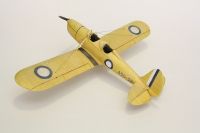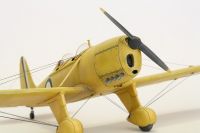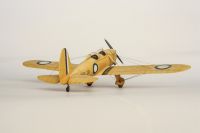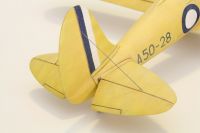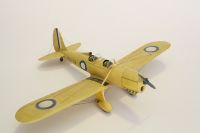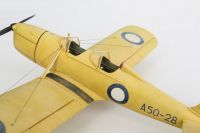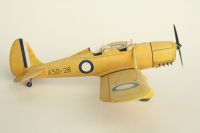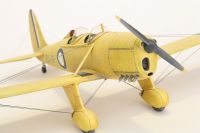Fisher Model and Pattern 1/32 Ryan STM
By Mike Prince
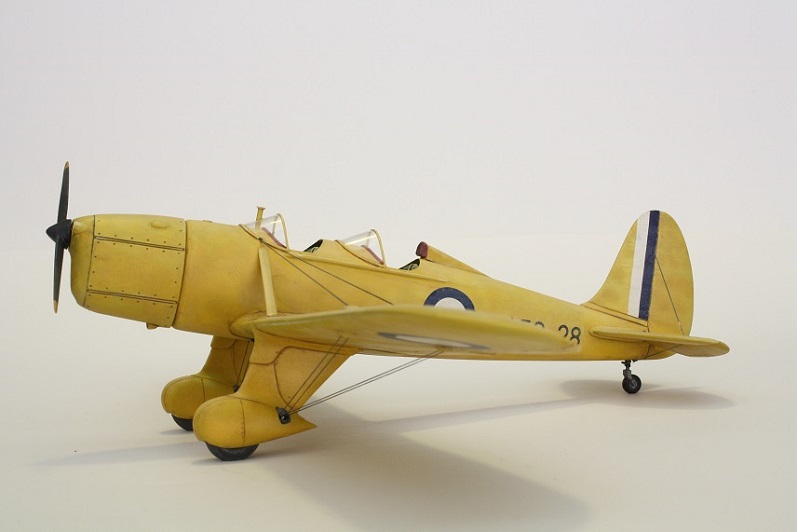
Introduction
The Ryan STM-S2 served in the Royal Australian Air Force in small numbers in WWII. They were initially acquired as a mix of 48 land and float planes by the Netherlands Naval Air Force, along with a larger order for their Army Air Force, but were shipped from Java to Australia as part of the general evacuation of the Netherlands East Indies in early 1942. The Army aircraft did not survive long enough to be evacuated. The naval Ryans arrived in crated condition, were re-erected and used for some time by their original owners before the remaining 34 were transferred to the RAAF, refurbished by QANTAS and refitted as land planes. The aircraft were then used by the Empire Flying Training Schools, as well as for communications and as squadron hacks – they were reportedly beautiful aircraft to fly, but could be twitchy to handle on the ground. In early 1945 the 23 survivors were sold out of service, with many ending up in civil flying schools. A number of them are still flying today.
For those interested, there is a fascinating history of the Ryan STM in Australia, by Greg Goodall, available via the following link: http://www.goodall.com.au/australian-aviation/ryan-stm/ryan-stm.htm
It covers their history all the way through from initial service with the Netherlands Naval Air Force, through to those still flying today. It includes many useful images.
The Kit
The Fisher Model & Pattern Ryan STM is an all resin kit. It is simple to build, with a low parts count, and for the most part fits together very well. The only place I found to need extra care was between the forward edge of the wing and the lower fuselage, with the narrow gap easily filled with sheet plastic. I also found it necessary to brace the seat backs within the cockpit as they only mount to the floor, which in turn is a little flexible. This bracing was added only on one side, before the fuselage was closed up, and can’t be seen on the completed kit.
Painting
As usual, this was the part I enjoyed the most. I was after a slightly neglected, sun faded aircraft, and wanted to avoid the common trap of weathering making the finish look darker. So, for an aircraft with a single overall colour scheme, I used a lot of colours to achieve the desired effects. Paints were Humbrol throughout, with the entire aircraft first undercoated in white. The wings were then rubbed back, leaving random areas of the wing rib tapes with the darker resin beneath exposed, as well as a few patches in between. This contrasted well with the remaining white undercoat. (Black would have given too much contrast). Starting on the yellow, darker areas such as the sides and lower surfaces were painted using various trainer and insignia yellows, with an uneven transition to Humbrol’s lighter and brighter gloss yellow on the sides, and allowing progressively more of the white undercoat, or bare resin, to show through on the fuselage spine and along the wing upper surfaces. In simple terms, instead of pre-shading, this was pre-fading. Panel lines around the engine were done in a medium grey / brown, with all others, including accumulated dirt on the underside, done with Middle Stone (light brown). Even though this is a light colour, it still contrasted well with the faded yellow finish. Once the markings and rigging were applied, a 50/50 mixture of Humbrol satin and matt clear finished things off.
Markings
Markings were from the kit. From other builds in LSP I knew (and confirmed) that the white in the markings is a little translucent, so these areas were left undercoated white by cutting and applying masking disks during initial painting.
Rigging
Rigging was completed using ‘Prym’ elastic from Wingnut Wings. One day I’ll be confident enough to do justice to one of their kits – it’s already in the stash.
Conclusion
Overall, the Ryan STM is a great little kit of what I think is one of the best looking ‘old fashioned’ aircraft ever made.
© Mike Prince 2015
This article was published on Saturday, October 31 2015; Last modified on Saturday, October 31 2015

